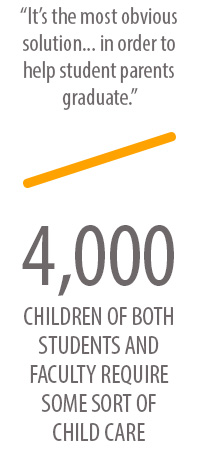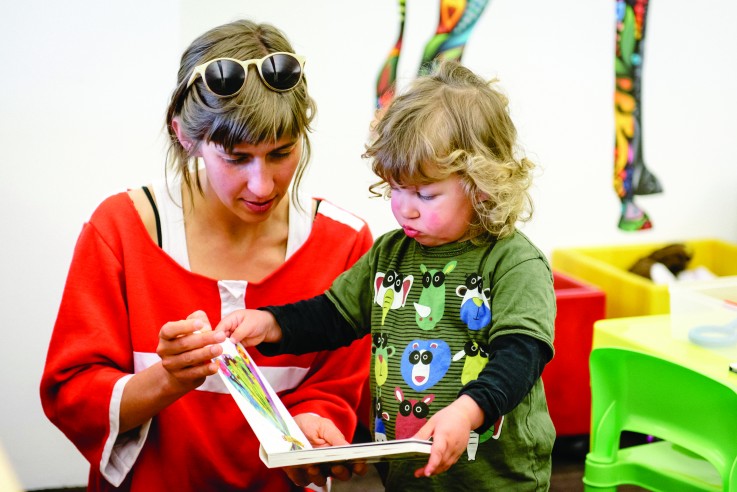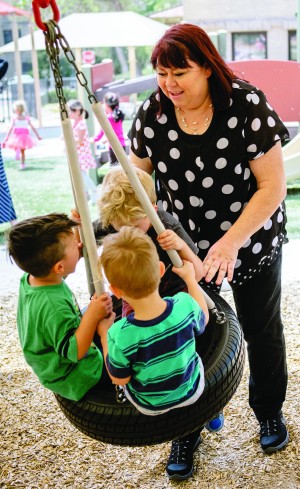The morning is a struggle for electrical engineering student Nick Elliott, who is operating on no sleep after pulling an all-nighter to study and finish homework that is now due. He rushes to head toward his two classes in differential equations and circuits, but on the way, he makes a stop at the Alfred Emery Building. There, in the “purple room” of the ASUU Student Child Care Center, he pauses for a moment with his 7-month-old daughter. “I try to set her down and get her used to sitting by herself so she doesn’t freak out when I leave,” he says. In about three hours, after his classes wrap up, Elliott picks her up from the center and tends her for the day while his wife, Alla, who is also a student at the University of Utah, attends her classes and works as an accounting clerk. He says there’s an art to balancing his schooling with responsibilities as a dad and work at Costco, where he spends three nights a week and a full shift on Saturday.
Elliott counts himself lucky to find child care on campus. “There aren’t many places that provide day care services for infants that are affordable,” he says. “When you total up how much it’s going to cost to have day care, it almost makes it insurmountable to finish school. It’s like, ‘Oh, how am I going to do this?’ ”
 The University of Utah is trying to make the answer to that question a little easier for student parents and nontraditional students with families. Providing affordable, on-campus child care for students is a high priority as a means to help prevent them from dropping out, alleviate possible debt, and enable them to graduate sooner.
The University of Utah is trying to make the answer to that question a little easier for student parents and nontraditional students with families. Providing affordable, on-campus child care for students is a high priority as a means to help prevent them from dropping out, alleviate possible debt, and enable them to graduate sooner.
“Our goals are to help, support, and enable our students to focus on their learning, and one of the ways we do that is assuring them that they have great, safe, high-quality spaces for their kids,” says Ruth Watkins, the U’s senior vice president for academic affairs. The University also is providing quality and convenient child care for faculty members as a way to attract and keep them.
About a quarter of the U’s 31,515 students are parents, and an estimated 4,000 children of both students and faculty require some sort of child care, from full-time day care to part-time, hourly services. The University has eight child care programs with a total capacity for 480 children, meaning that only about 10 percent of the child care needs are being met on campus. Yet the U is doing much more than most colleges and universities across the country. In January, the University of Utah was ranked No. 2 in the nation by BestColleges.com as a top school for nontraditional students, and the University is expanding child care and other family-friendly services even as institutions nationwide are cutting back because of funding constraints.

From left, Hanna Kordy, Haylee Puga, and Kate Rasmussen study a plant’s growth, in the University of Utah’s Child and Family Development Center.
The ASUU Student Child Care Center groups children by ages in five rooms painted different colors. The center opened a purple room this past January, to provide part-time hourly care for infants at the U, a first on the campus. Within the past year, the University also added lactation rooms across campus, and starting in May, all new buildings and renovations totaling more than $10 million must include designs for a lactation space. In all, the University now has 21 private rooms for nursing mothers, and three more will be located in the new S.J. Quinney College of Law building when it opens this fall.
****
Afamily reading room where parents can study while their children play also opened last fall at the J. Willard Marriott Library, along with three adjacent lactation rooms. And renovation of the Child and Family Development Center, located next to the ASUU care center, is planned for next year.

Debra Daniels, right, director of the U Women’s Resource Center, with student Victoria Farrimond and her daughter Tori Anne.
Lindsey Reichlin, research and program coordinator for the Institute for Women’s Policy Research in Washington, D.C., says the U’s efforts to provide comprehensive child care options are “fantastic.” “For students with children, child care can be one of the biggest, if not the biggest, factors in a student’s ability to complete college and be successful,” she notes. “It’s the most obvious solution that schools can seek to provide in order to help student parents graduate.”
Even so, fewer colleges nationwide are providing such services. The research institute, which follows women’s policy issues in the United States, released two studies last November that found child care services on campuses across the country are declining, even as the number of student parents is increasing. According to one of the studies, 26 percent of U.S. college students, or 4.8 million undergraduates, have children, and 71 percent of those students are women.
From 1995 to 2011, the number of student parents increased by more than 1.6 million. Meanwhile, the number of four-year institutions providing child care decreased from 54 percent to 51 percent from 2002 to 2013, and federal funding for child care through CCAMPIS (Child Care Access Means Parents in School) grants dropped from $25 million in 2001 to $14.8 million in 2013. (The University of Utah received one of the coveted grants, totaling $1.3 million, last year.) Students with children also have much higher debt after graduation, the study found.
Reichlin says the numbers are concerning. “When you’re having to balance so many competing responsibilities, child care plays an even greater role,” she says. “Child care is the crux in a lot of ways.”
****
The U has made child care a priority, in part, because the unique demographics of both the University and the state of Utah dictate that focus, Watkins says. “I do think that our undergraduate student population is very different than most flagship universities, and I think that puts some special responsibility on us to think about this creatively and assertively.”
 A higher proportion of Utahns—28 percent, compared to 22 percent of people nationwide—has taken some college coursework without finishing. “That does tell us that we do have a fair number of working-age adults who have started college but haven’t been able to complete their degrees,” Watkins says.
A higher proportion of Utahns—28 percent, compared to 22 percent of people nationwide—has taken some college coursework without finishing. “That does tell us that we do have a fair number of working-age adults who have started college but haven’t been able to complete their degrees,” Watkins says.
At the same time, more than half of students at the U are taking six years or longer to graduate, and for the past decade, nearly a third of students enrolled at the U have been over age 25. “That then leads us to question, ‘What’s different about our population and our students?’ ” Watkins says.
Two important factors are that half of undergraduates at the U marry before they complete their degrees, and about a quarter of students have one or more children before graduating. Many students also delay their education to serve religious missions for the Church of Jesus Christ of Latter-day Saints, and because those students are older when they return to school, they are often also starting families.
“As an institution, possibly the single most important thing we’re working on is increasing the retention and graduation rate of our students,” says Watkins. “So that leads us to look at the most important things to be doing to promote student success, and clearly one of them is to help our students with access to quality child development and child learning opportunities.”
Mary Parker, associate vice president of student affairs at the U, agrees that the picture is different in Utah than in other states, especially when it comes to women in higher education and the number who graduate. “We know we have to do a better job of helping young women understand the importance of an education and how that helps their families.”
According to the U’s Office of Budget and Institutional Analysis, 45 percent of undergraduate students enrolled at the U this year are women, compared to 55 percent who are men. Nationally, more women than men are enrolled in public universities, at a ratio of 56.4 percent to 43.6 percent.
When students begin families, their finances also can become stressed. The U surveys students who are enrolled one semester but not the next, and the number one reason they indicate for not coming back is “financial constraints.”
“Student parents take longer to graduate, and many times it’s because they go to school, work a semester, go to school, work a semester,” says Parker. Once they do leave, she notes, there’s a strong risk they won’t come back. To help students defray some of their costs, the University is utilizing the CCAMPIS funds it received from the U.S. Department of Education to subsidize child care for low income students during the next four years, through the duration of the grant. About 150 families at the U now receive such subsidies each year.
 The University has an array of campus child care options. The U’s Center for Child Care and Family Resources manages the ASUU Student Child Care Center, which offers a variety of services such as drop-in evening care, free finals week care, and a “Parent Night Out” one Saturday per month for students. The center, which is open from 7:15 a.m. to 9 p.m. Monday through Thursday and until 6 p.m. on Fridays, serves 160 children ages six weeks to five years. Student parents sign up each semester for the hours they need to cover for study or classes, and a sliding scale based on income is used to calculate cost.
The University has an array of campus child care options. The U’s Center for Child Care and Family Resources manages the ASUU Student Child Care Center, which offers a variety of services such as drop-in evening care, free finals week care, and a “Parent Night Out” one Saturday per month for students. The center, which is open from 7:15 a.m. to 9 p.m. Monday through Thursday and until 6 p.m. on Fridays, serves 160 children ages six weeks to five years. Student parents sign up each semester for the hours they need to cover for study or classes, and a sliding scale based on income is used to calculate cost.
****
Shauna Lower, director of the Center for Child Care and Family Resources, says the efforts are making a difference. “There are parents with infants, in particular, who have said, ‘I am so thankful. I wouldn’t be in school right now.’ Some have dissolved into tears when they’ve heard there is a space.”
Other child care programs at the U include the BioKids center, started by faculty in the biology department in 2000. It provides full-time care to children ages six weeks to five years, and generally has about a nine-month waiting list. The Child and Family Development Center, which opened back in 1930, is the oldest program on campus. It primarily serves as a child care development lab for University students studying early childhood and human development, and enrolls children ages 18 months to five years in a three-hour morning or afternoon session.
There’s also the Early Childhood Education Center, a full-time center that mainly serves employees’ children ages two to eight years, and the Fine Arts Preschool for children ages three to six. The full-day University Kids, a private national program run by Children’s Creative Learning Center, enrolls children ages six weeks to eight years, and University Head Start provides morning and afternoon classes for three- and four-year-olds. And then there’s Club U and Youth Academy, summer programs run by U Continuing Education.
“If you’re looking at Pac-12 schools, most of them do not have child care at this level,” Lower says. “Even in the state, having eight programs that serve children in different capacities is pretty unique.” Lower knows firsthand the challenges of juggling school and child care. “I’ve experienced all of this. I’ve taken children to class before, which is an awful experience.” She says she wants to make it easier for students at the U: “I don’t think wanting to be a parent should stop you from going to school.”

Erin Beeghly, a University of Utah assistant professor of philosophy, with her daughter Esme Rivkin in the Marriott Library’s Family Reading Room.
Debra Daniels MSW’84, director of the Women’s Resource Center at the U, notes that by far, women shoulder the responsibility for finding and providing child care. To help, her office provides emergency grants to students each year. The grants, funded by a number of foundations, range from $10 for a needed stroller, formula, or diapers, to thousands of dollars for a child care voucher or help with tuition.
 The goal is to keep student parents, especially mothers, in school. “We know that if they step out, the chance is slim to none that they will come back,” she says.
The goal is to keep student parents, especially mothers, in school. “We know that if they step out, the chance is slim to none that they will come back,” she says.
U student Cassie Smith has three young children who are enrolled at the ASUU child care center for a few hours here and there while she goes to class and studies. “I wouldn’t be able to go to school if I didn’t have this,” she says. Her husband just graduated from the U with a master’s degree, and while she has had to take some semesters off due to parenthood, she plans to graduate this summer in elementary education after enrolling six years ago.
Elliott, whose daughter is in the infant room at the ASUU center, says student parents face many challenges that other students don’t. “It’s intimidating, too, because sometimes you may not get the academic performance that you would like maybe because of all the other things that are going on.” But there’s no question that having a child as a student also has its pluses, he says. “It’s surprising how much motivation there comes from that. No matter how stressed you are, you always find little times of thinking, ‘Oh, I get to go see my baby.’ And that cheers you up. It’s weird how that works.”
Web Exclusive Photo Gallery
[nggallery id=110]


Great article. Congrats to the U for being sensitive to the needs of their students. It makes one wonder what solutions the other 90 percent of the children have and how many are left home alone. No wonder parents burst into tears when they find that they qualify for quality care for their children on campus. Keep up the good work. Great pictures, also.